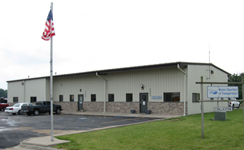Category:105 Control of Work

The many aspects of control of work, including the the responsibilities of the resident engineer, preconstruction conferences, duties of inspectors and acceptance of small quantities, are presented in this article. Also discussed is how the District Construction Engineer is directly responsible to the district engineer and expected to operate as the district engineer's representative.
105.1 Construction Inspection Guidance for Sec 105
Load Restrictions (Sec 105.12)
A special provision dated April, 1964 is included in all contracts when the plans or special provisions require that material from roadway or borrow excavation be hauled across existing pavement and the contractor elects to move the material across the pavement with equipment that results in overweight loading. The provision requires that the contractor obtain written permission from the resident engineer prior to movement of overweight loads across the existing pavement. The provision further provides stipulations that must be followed during the time of hauling and upon completion of the hauling operations. When this particular special provision is included in a contract it will not be necessary for the contractor to obtain overweight hauling permits from the Motor Carrier Services Division nor will it be necessary for the district to give that office their recommendations regarding an overweight permit. However, under all other circumstances, it will be necessary for the contractor to request an overweight permit from Motor Carrier Services (1-866-831-6277), and for the district to furnish that office with their recommendations. All overweight truck crossings will be by an agreement that must be approved by the Chief Engineer and the Commission. In no case will such overweight truck crossings be approved by issuance of the "Contract for Signs at Truck Crossing", by a Driveway Permit, or by a Special Permit. The request should be forwarded to the Construction and Materials Division with the following information:
- Make,
- Model,
- Gross weight (loaded) and
- Axle spacing of equipment that will be used for hauling.
In most cases, the agreement will require reconstruction of the roadway section to withstand the repeated overloads at the contractor’s expense.
In some situations the contractor may wish to move overweight/over dimension equipment across an existing MoDOT structure (i.e. a bridge) open to traffic. When this occurs, the contractor must inform the resident engineer who then forwards the request to the Bridge Division for review and analysis. This request must be provided to the Bridge Division three weeks prior to the scheduled bridge crossing. The request must include:
- Longitudinal and transverse dimension of the item to be moved
- Axle weights and
- The length and width of the vehicle’s tracks (if it has tracks).
The Bridge Division will review this material to determine if there are any structural issues associated with moving the vehicle across the structure. They will inform the resident engineer of their approval or denial of the contractor’s request. No "special permit" is necessary.
Hours of Operation
If operation is after daylight hours, mercury vapor lighting will have to be provided by the contractor.
Exact location
The station number and the sight distance from both directions with a plan and profile sheet will be provided. A signal with red and amber lens controlled by a flagman will be required and provided by the applicant. State route traffic will have right-of-way at all times.
The length of time the crossing will be in effect.
In most cases, one or two years with renewable options are included in the agreement. On State routes with heavy traffic volumes, it may be more feasible to consider a grade separation or an adjustment of hours of operation to miss peak periods of traffic.
It is necessary to inform Motor Carrier Services (1-866-831-6277) when traffic is being placed in its final position on newly constructed roadways. It is the duty of the resident engineer to notify Motor Carrier Services whenever a new section of roadway under construction has traffic, traveling through the project, placed in its final position. Also, whenever any temporary restrictions are either implemented or removed in a construction project, Motor Carrier Services should be advised in order to provide the necessary routing guidelines to common carriers moving through these projects.
Vertical Clearance
Vertical Clearance concerns are discussed in construction inspection guidance for Structures.
Stockpiling Material on Bridge Decks
The contractor shall not be allowed to store or stockpile any material on a bridge deck without the approval of the engineer. If for project operations it becomes necessary for the contractor to request to store or stockpile material, the contractor shall submit a written request to the engineer that is signed and sealed by a professional engineer from Missouri. This request shall include an evaluation with both dead and live load calculations to ensure that the material is safe to store. This information shall be forwarded for evaluation to the bridge office via the District Liaison Engineer for Bridge. The engineer may determine that storage of minor material quantities, such as light materials or small quantities that can not effect the bridge loading, is acceptable on a case-by-case basis without the submittal of a signed and sealed written request. The Resident Engineer may request the assistance of the Bridge Division to review the contractor's proposal for minor material quantities.
Media in category "105 Control of Work"
This category contains only the following file.
-
105.19 Digital Signature Example 06-23.jpg 1,367 × 592; 274 KB
